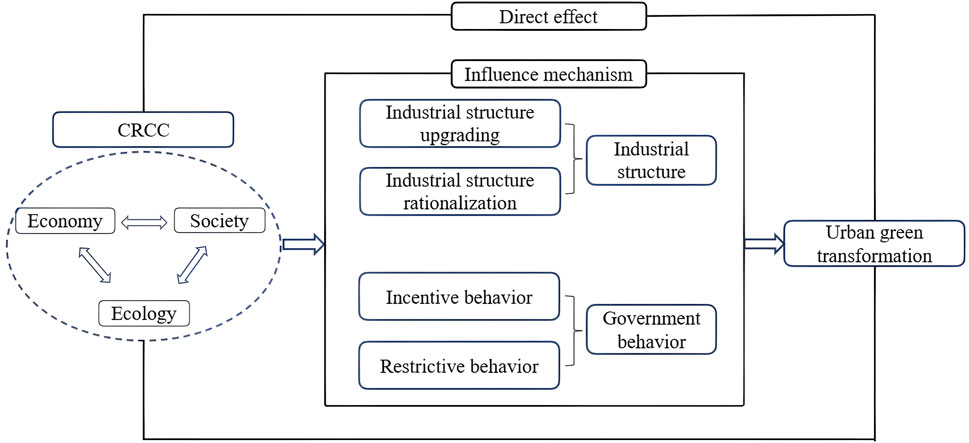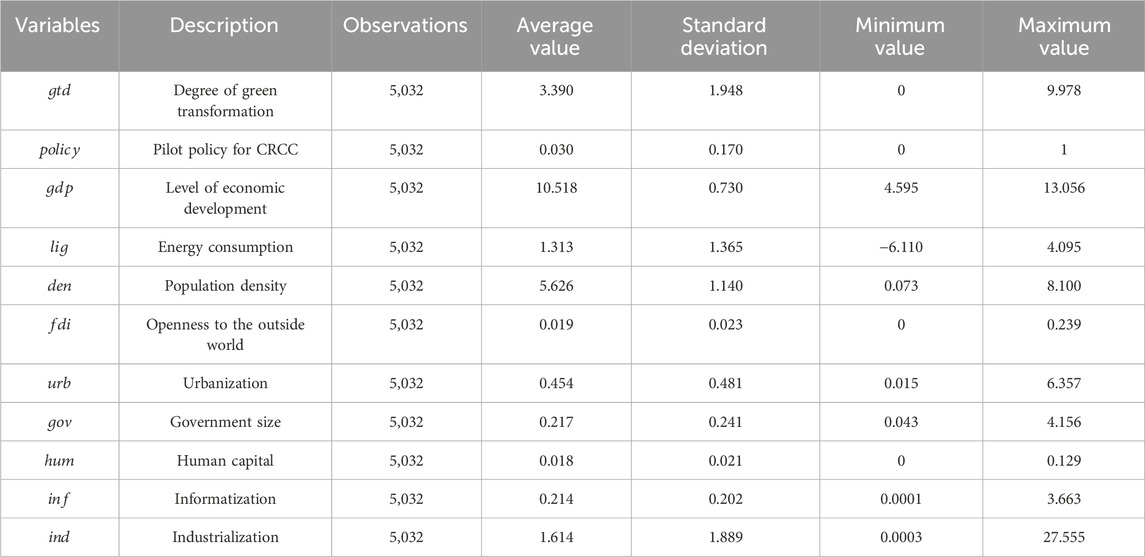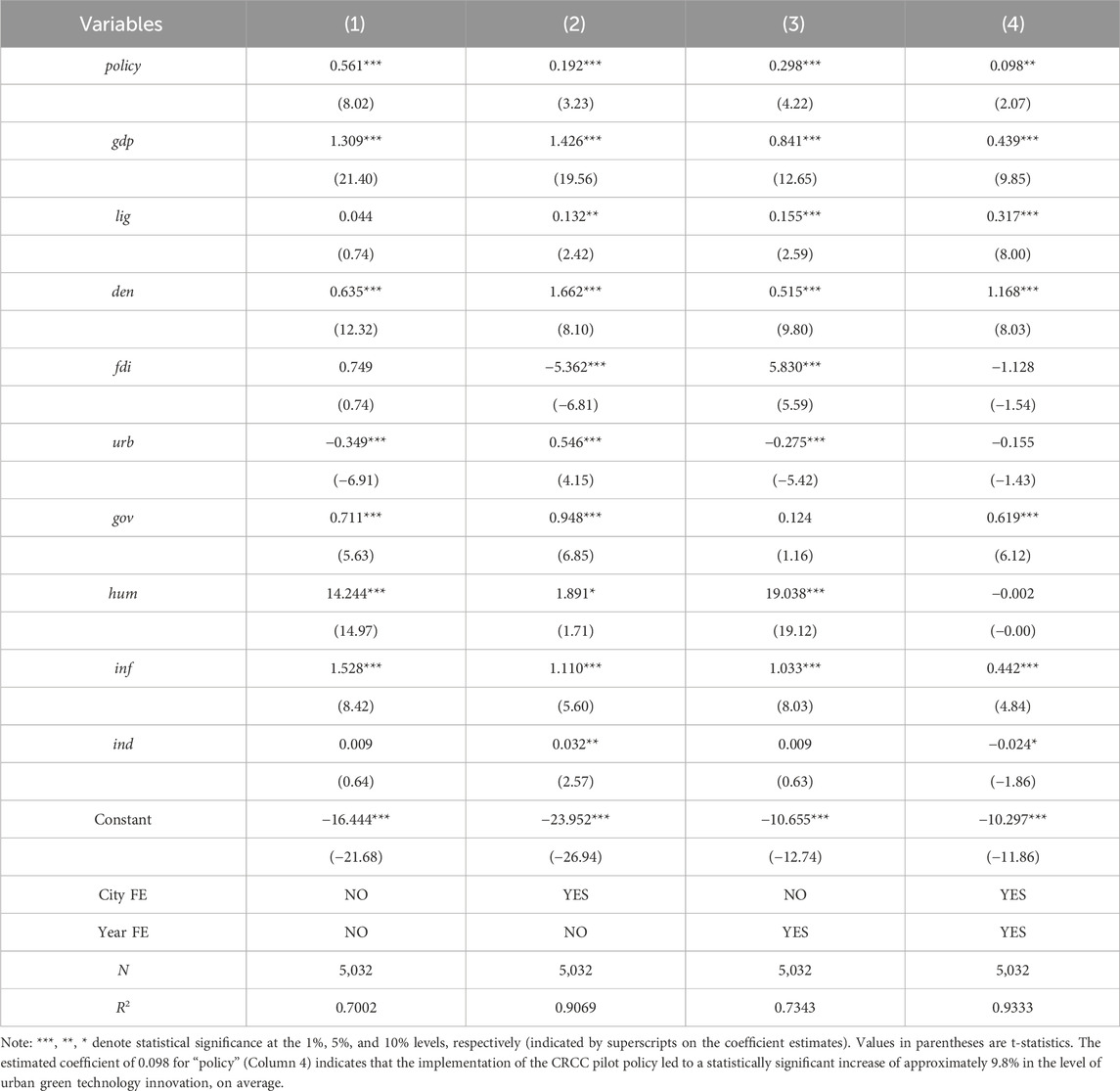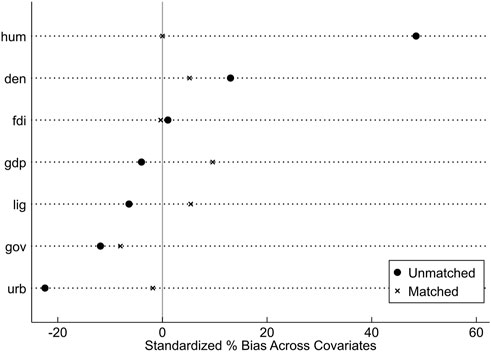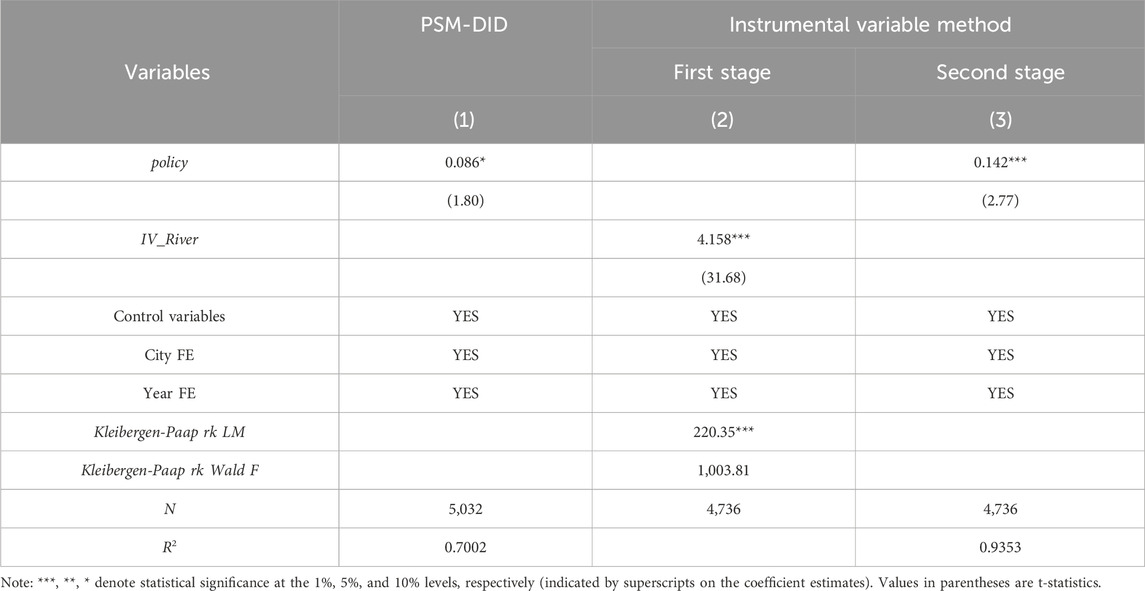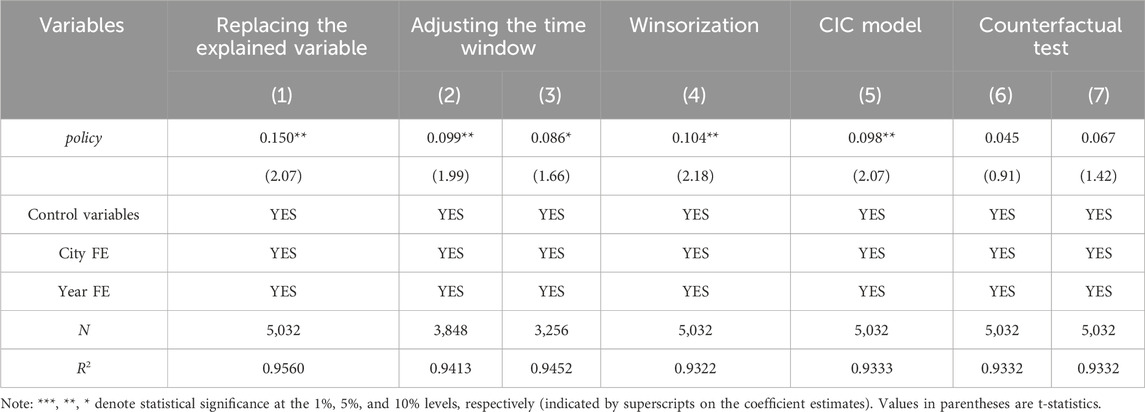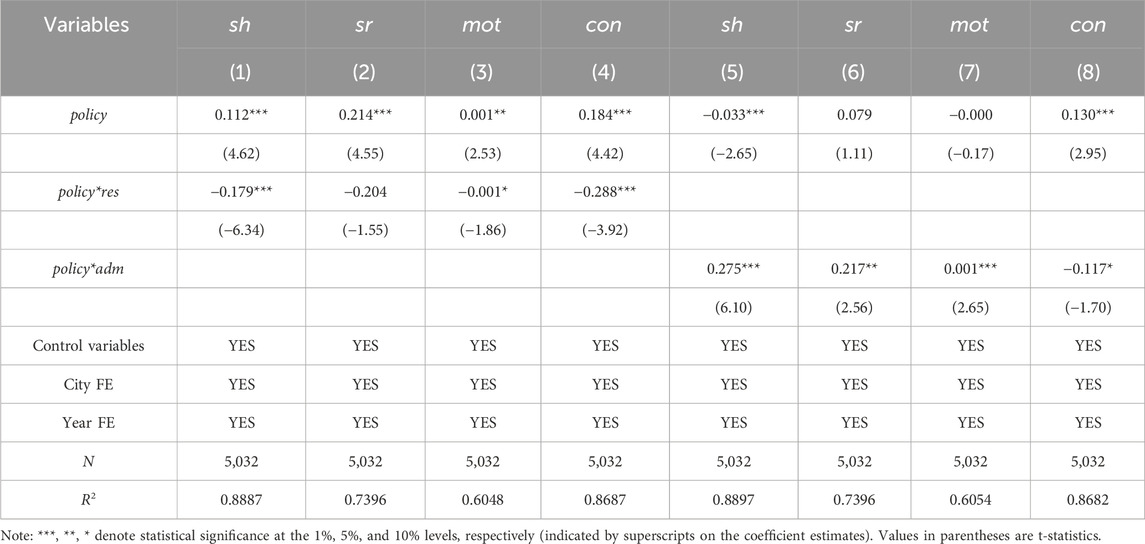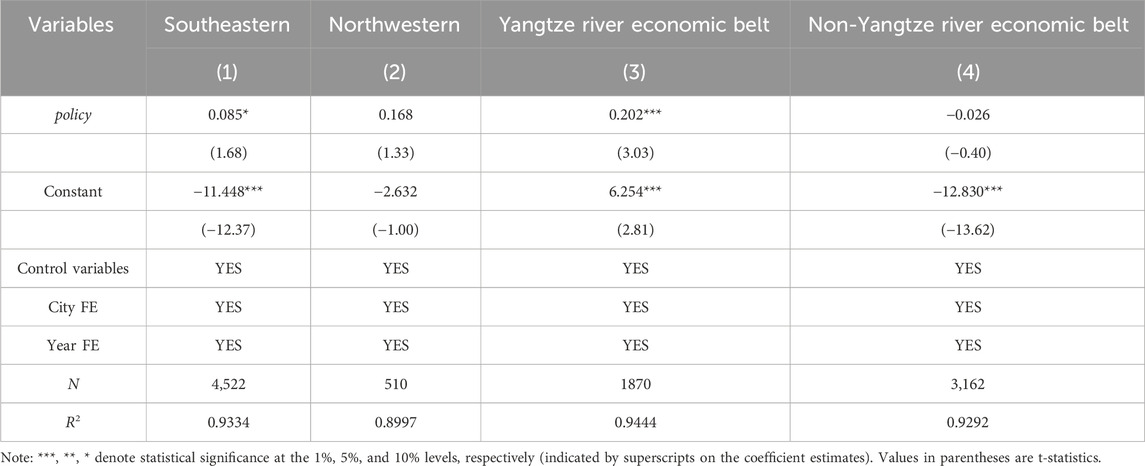- 1The School of Finance, Hunan University of Technology and Business, Changsha, China
- 2Department of Economics and Management, Weifang Engineering Vocational College, Weifang, China
- 3Business School, Hunan First Normal University, Changsha, China
- 4Law School, Central University of Finance and Economics, Beijing, China
Methods: This study constructs a quasi-natural experiment leveraging the pilot policy for climate resilient cities construction (CRCC), utilizing panel data from 296 prefecture-level cities in China spanning from 2006 to 2022. The Difference-in-Differences (DID) method is employed to identify the causal effect of CRCC on urban green transformation.
Results: Empirical results show that CRCC significantly accelerates urban green transformation, with a 9.8% increase in green technology innovation. Mechanism analysis reveals that CRCC drives green transformation through industrial structure optimization and upgrading, as well as governmental incentive and regulatory actions. Additionally, the promoting effects of CRCC on industrial structure upgrading and governmental behavioral adjustments are weaker in resource-based cities, while in cities with higher administrative hierarchy, CRCC more effectively drives green transformation by accelerating industrial structure optimization and strengthening governmental incentive behaviors. Heterogeneity analysis shows that the positive effect of CRCC on green transformation is more pronounced in cities located on the southeast side of the Hu Line, and cities within the Yangtze River Economic Belt. Extended test results indicate that CRCC has a considerable enhancing effect on the green transformation of neighboring cities, and that green transformation exhibits a positive spatial spillover effect.
Conclusion: For the first time, this study quantifies the causal effect of CRCC on urban green transformation using panel data, filling a research gap in the role of climate resilience policies in green development.
1 Introduction
Climate change ranks among the most complex and far-reaching global crises the world is currently facing. Cities, being highly concentrated areas of population, industries, and energy consumption, are inherently major sources of greenhouse gas emissions (Yu Q. et al., 2024). In recent years, extreme climate events such as heavy rainfalls, floods, heatwaves, and the urban heat island effect have occurred with increasing frequency and severity (Li et al., 2023). These events have inflicted substantial impacts on urban infrastructure, residents’ lives, and economic development. The rapid progress of urbanization has exacerbated resource consumption, environmental pollution, and the vulnerability of urban systems. Consequently, issues related to urban sustainable development triggered by climate change have become increasingly prominent. Urban green transformation represents a systematic overhaul of urban development models, aiming to achieve coordinated goals of resource conservation, environmental friendliness, and low-carbon development through economic structure optimization, production mode transformation, and social lifestyle adjustment (Sharifi et al., 2024).
In July 2024, “Opinions of the Central Committee of the Communist Party of China and the State Council on Accelerating the Comprehensive Green Transformation of Economic and Social Development” explicitly emphasized that encouraging the green and low-carbon transformation of economic and social development is the key to achieving high-quality development and the foundation for resolving resource and environmental issues. It is essential to integrate green transformation into all aspects and build a community of life where humanity and nature coexist harmoniously. China’s “dual-carbon” goals of carbon peaking and carbon neutrality, proposed in 2020, further anchor these efforts. These goals not only align with the Paris Agreement’s mandate to limit global warming to well below 2°C but also underscore CRCC’s role as a tangible pathway for urban decarbonization. By promoting low-carbon industrial transformation and green technological innovation, CRCC exemplifies how developing economies can balance climate resilience with sustainable development under international climate frameworks.
However, in previous urban green transformation practices, the consideration of climate resilience capacity has been relatively insufficient. Global climate governance strategies have mostly focused on climate mitigation, emphasizing energy conservation and emission reduction measures. This has led to an imbalance between climate mitigation and resilience actions. The frequent occurrence of extreme climate events and the resulting severe disasters, as well as biodiversity losses, have highlighted the mismatch between current resilience measures and the increasingly severe climate risks. Therefore, urban green transformation should not only attach importance to mitigation strategies for greenhouse gas emissions reduction but also place greater emphasis on resilience actions such as establishing multi - hazard early warning systems and building resilient urban infrastructure to comprehensively address the challenges of climate change.
In accordance with the “Action Plan for Urban Resilience to Climate Change”, in 2017, the National Development and Reform Commission and the Ministry of Housing and Urban-Rural Development selected 28 cities as pilot projects for CRCC, providing a demonstration for promoting climate resilience efforts and urban green transformation in China. CRCC refers to a development strategy that enhances cities’ capabilities to withstand extreme climate events through systematic policy design and implementation, while promoting the sustainable transformation of urban economies, societies, and ecosystems. This paper intends to use the difference-in-differences (DID) method to analyze the impact of this pilot policy on urban green transformation, and deeply explore its mechanism of action, heterogeneity, and spatial effects. This article aims to explore the path of urban green transformation and provide policy recommendations for deepening urban climate resilience efforts.
This article comprises seven sections, organized as follows: The second part reviews the literature review. The third part presents the theoretical analysis and research hypothesis. The fourth part outlines the research design, encompassing variable selection, model setting, and data description. The fifth part displays the results and discussion. The sixth part offers further analysis. The seventh part concludes the study and puts forward policy recommendations.
2 Literature review
Literature relevant to this paper can be mainly classified into three categories. The first category consists of research on climate resilience. Shen et al. (2023) utilized the survey data of rural residents in Shanxi and Ningxia and found that farmers’ climate-change-resilience behaviors effectively alleviated water poverty. There are also scholars who have conducted horizontal and vertical studies on China’s climate-resilience policies. For example, Huang et al. (2021) analyzed and compared the characteristics and strategic evolution of the climate-resilience governance systems in China, Germany, and the United Kingdom, and proposed suggestions for improving China’s climate-resilience policy system from three dimensions: technology, capital, and resilience knowledge. As the severe challenges of global climate change become increasingly prominent, the BRICS countries, as important representatives of emerging developing countries, have successively introduced targeted climate-change policies and carbon-emission-reduction measures driven by the carbon-neutrality goal. The research by Zheng et al. (2023) provides valuable insights for us to deeply understand the policy evolution of the BRICS countries in the field of climate-change response.
The second category focuses on the influencing factors of urban green transformation and development. Many scholars, based on different perspectives and research objects, have examined the impact of technological innovation on the green development of Chinese cities. Some scholars have also explored the role of the digital economy in urban green development, and proposed that the positive impact of the digital economy on urban green development has time-lag characteristics (Wei and Hou, 2022) and heterogeneity (Liu et al., 2024). Li et al. (2022) pointed out that the growth of green total factor productivity in resource-based cities is slow. From the government’s perspective, local government green assessment significantly affects the green transformation of resource-based cities (Wang, 2024; Ren et al., 2024). There are differences in the green transformation performance among Chinese cities (Ren et al., 2023). The green development efficiency of cities in the western region first increases and then decreases, and the problem of spatial imbalance is relatively serious (Dou et al., 2023).
The third category concentrates on the policy effects of various policies on urban green transformation. Many scholars have examined the policy effects of national policies, such as the “Belt and Road” Initiative (Wang and Cheng, 2024), the pilot policy for low-carbon city construction (Zeng et al., 2023; Ma and Zhu, 2024), the pilot policy for national innovative city construction (Li et al., 2022; Zhang and Zheng, 2023), the construction of pilot demonstration cities for “Made in China 2025” (Wang W. L. et al., 2023), the construction of national-level urban agglomerations (Yuan et al., 2024), the new energy demonstration city policy (Liu et al., 2024), the transportation corridor of the China-Europe Railway Express (Mao et al., 2024), the vertical reform of environmental protection agencies (Zhang et al., 2024), the construction of national independent innovation demonstration zones (Yu et al., 2023), the smart city construction (Chen et al., 2024), and the establishment of Shanxi’s “Comprehensive Reform Zone” (Liu et al., 2024).
By reviewing the existing literature, the following points are found: first, current literature on climate resilience has expanded to urban-level mechanisms, with recent studies like Mahmoud et al. (2025) analyzing the EU’s Green City Accord and its emphasis on decentralized governance in Copenhagen. However, compared to China’s CRCC, which integrates top-down policy piloting with industrial upgrading (Wu et al., 2024), global research on urban resilience still lacks systematic analysis of developing economies’ needs. Second, the current research on the influencing factors of urban green transformation and development concentrates on technological innovation, economic development, resource consumption, environmental regulation, etc. There is relatively little exploration of the role of climate resilience in urban green transformation from the perspective of climate resilience. Third, although existing research has focused on the policy effects of multiple national policy pilot constructions on urban green transformation, few studies have paid attention to the impact of CRCC on urban green transformation. The research on the mechanism analysis, heterogeneity analysis, and spatial effects of the relationship between the two is not comprehensive enough.
Climate change poses unprecedented challenges to urban sustainability, with cities increasingly recognizing the need to integrate climate resilience into green transformation strategies. While existing research has made notable contributions, a critical examination reveals distinct gaps in our understanding of how CRCC influences urban green transformation. These gaps primarily manifest in three interrelated areas, which this study aims to address.
First, the majority of literature on climate resilience remains concentrated at the agricultural household level or focuses on comparative policy analysis across nations, with surprisingly limited exploration of urban-level resilience mechanisms. This oversight is particularly problematic because cities, as hubs of economic activity and carbon emissions, face unique challenges in balancing mitigation and adaptation strategies. For instance, while rural resilience research has highlighted farmers’ adaptive behaviors (Li, 2023), urban contexts require distinct frameworks to address infrastructure vulnerability, industrial carbon footprints, and systemic governance gaps.
Second, existing studies on urban green transformation have predominantly focused on technological innovation, environmental regulation, or economic development factors (Lin et al., 2024; Wu et al., 2024), but the specific pathways through which CRCC policies drive green transformation lack systematic analysis. Notably, the interactive effects between industrial structure adjustment and governmental behavior have not been empirically tested. For example, while studies have shown that industrial upgrading enhances green total factor productivity (Hunjra et al., 2024), whether CRCC specifically accelerates this process through policy-induced industrial restructuring remains unquantified. Similarly, how governmental incentives and restrictive measures synergistically promote green transformation requires more rigorous empirical validation.
Third, the spatial dimension of CRCC effects has been largely overlooked. Most policy evaluations of urban green transformation focus on single-region impacts, ignoring potential spillover effects that could shape regional sustainability dynamics. For example, while the “pollution haven” hypothesis has been explored in the context of FDI (Chiriluş and Costea, 2023), whether CRCC in one city promotes green innovation in neighboring regions through knowledge diffusion, policy emulation, or resource reallocation remains a novel research frontier. This gap is particularly relevant for China’s urban agglomerations, where spatial interdependencies may amplify or mitigate the effectiveness of CRCC.
In view of this, based on the panel data of 296 prefecture-level cities from 2006 to 2022, this paper constructs a DID model to study the impact of the pilot policy of CRCC on urban green transformation. The marginal contributions of this paper are mainly as follows: first, innovatively combining CRCC with urban green transformation, this paper systematically evaluates the direct impact of CRCC on urban green transformation by constructing a quasi-natural experiment. This not only enriches the evaluation dimensions of the effects of CRCC but also provides new empirical evidence and theoretical support for urban green transformation strategies. Second, from the perspectives of multiple mechanisms such as the optimization and upgrading of the industrial structure, and the government’s incentive and restrictive behaviors, this paper deeply analyzes the internal logic of how CRCC promotes urban green transformation, offering more in-depth insights into the relationship between climate resilience and urban green transformation. Third, given the regional disparities in China’s urban development, grouped regression within the DID framework can effectively capture the heterogeneity in policy effects. When combined with spatial econometric models, this approach further examines the spatial spillover effects of green transformation, forming a three-dimensional analytical framework that integrates “individual effects-group differences-spatial correlations.” This methodological combination breaks through the limitation of traditional DID, which typically focuses only on policy effects in single regions, and innovatively reveals the regional synergistic effects of CRCC.
3 Theoretical analysis and research hypothesis
3.1 Climate resilient cities construction and urban green transformation
China’s climate resilience policy system is characterized by its national strategic importance, policy systematization, and cross-departmental collaboration (Cui et al., 2024). However, existing policies face issues when dealing with climate governance, such as insufficient understanding of climate change at the grassroots level, weak basic capabilities, imperfect working systems and supporting guarantee measures, and unsound cross-departmental cooperation mechanisms (Sibiya et al., 2022). Therefore, implementing the pilot construction policy of climate resilient cities, featuring comprehensive planning, adaptable actions tailored to local conditions, institutional and mechanism innovation, and coordinated monitoring and early warning, becomes the key to solving these problems. Previous research indicates that local government departments lack a climate monitoring and evaluation system and a scientific evaluation process, which prevents them from providing precise guidance for climate change resilience practices and forming effective feedback (Biswas and Rahman, 2023; Chen et al., 2023). Moreover, the absence of an organizational and coordination mechanism for climate change resilience among the national, regional, and departmental levels leads to unclear main responsibilities for climate change resilience (Cid and Lerner, 2023). To improve China’s climate resilience policies and further strengthen the closed-loop management of the policy framework, in 2017, the National Development and Reform Commission and the Ministry of Housing and Urban-Rural Development jointly issued the “Notice on Printing and Distributing the Pilot Work of Climate Resilient City Construction”, designating 28 regions represented by Hohhot and Dalian as pilot areas for climate resilient city construction. The aim is to create a policy resilience base and deeply integrate the concept of climate change resilience into the entire process of urban construction and management.
The theoretical connection between CRCC and urban green transformation is rooted in the theories of sustainable development and transition, which are organically linked through a “pressure-response” mechanism. The essence of CRCC is to encourage cities to innovate in the institutions, technologies, and mechanisms of climate change resilience, so as to give play to the demonstration, breakthrough, and driving roles of the pilot projects (Zhang Y et al., 2024). On the one hand, from the perspective of ecosystem restoration and spatial layout optimization, the pilot policy supports the implementation of ecosystem protection and restoration projects. It also guides cities to accelerate the formation of a green-development spatial pattern, and build a complete urban ecological network. On the other hand, as seen from industrial structure adjustment, the pilot policy provides financial guarantee for scientific and technological innovation. It helps the advancement of intelligent urban management systems and the application of technological achievements in urban construction. Meanwhile, it phases out backward industries and the development of green industrial chains. Therefore, this paper proposes Hypothesis 1.
Hypothesis 1. Climate resilient city construction contributes to accelerating urban green transformation.
3.2 The influence mechanism of CRCC on urban green transformation
3.2.1 Industrial structure
The industrial structure mechanism is anchored in the resource reallocation theory. CRCC’s green entry standards facilitate the exit of backward production capacity and the expansion of green industries. This aligns with the “structural dividend” hypothesis, where industrial upgrading improves resource efficiency and spurs green innovation. Firstly, the pilot policy of CRCC guides industrial optimization and elimination by setting green standards for industrial access. This policy framework, based on multiple dimensions such as environmental carrying capacity, resource utilization efficiency and carbon emissions, screens out and phases out backward production capacity, thus reallocating resources to industries with greater development potential and more pronounced green features (Gao et al., 2025). Secondly, the government adopts a variety of policy measures to increase the proportion of green industries in the urban industrial structure and foster new economic growth points (Sun and Feng, 2023). Finally, regarding existing traditional industries, the pilot policy encourages collaborative innovation between traditional and low-carbon industries, propelling the transformation of the industrial structure towards green and advanced forms. Existing research has widely confirmed that the upgrading process of the industrial structure is conducive to improving the urban green total factor productivity, and stimulating the vitality of green technology innovation (Wang Y. et al., 2023; Yan et al., 2023).
3.2.2 Government behavior
Government behavior builds on the “Porter Hypothesis,” which posits that well-designed environmental policies can induce innovation to offset compliance costs (Lee, 2020). CRCC’s incentive tools and restrictive measures reflect a dual governance approach. To address market failures, government incentive measures are of great significance. Government incentives in the pilot policy are mainly reflected in two aspects: first, the government, through means such as setting up special funds, providing financial subsidies, and offering tax incentives, encourages social capital to flow into green projects (Wang and Zhang, 2024). Second, government departments actively build urban climate change monitoring and prediction platforms, so as to enhance the climate resilience of urban infrastructure and the service capabilities of the ecosystem (Shang and Lv, 2023).
The government’s policy intervention in urban green transformation also includes restrictive behaviors. The pilot policy emphasizes planning constraints and project risk assessment, requiring cities to incorporate climate change responses and green transformation measures into their designs. The government’s restrictive behaviors are specifically reflected in two aspects: one is the restriction on resource utilization. The government strengthens the regulation of key urban resources such as water, land, and energy, and raises the threshold for industry access (Deng and Wu, 2024). The other is the strict limitation of pollutant and carbon emissions. The government sets clear standards for various pollutant emissions, covering exhaust gas, wastewater, solid waste, etc., determines the total carbon emission target, and decomposes it to various industries and enterprises (Liu et al., 2023; Liu and Yin, 2024). Based on the above analysis and drawing on the basic principles of sustainable development policies, this paper constructs the impact pathway diagram of CRCC on urban green transformation, as shown in Figure 1. Accordingly, we put forward Hypothesis 2a and Hypothesis 2b.
Hypothesis 2a. CRCC facilitates urban green transformation through the upgrading and rationalization of the industrial structure.
Hypothesis 2b. CRCC promotes urban green transformation through the government’s incentive and restrictive behaviors.
3.3 Heterogeneity analysis of the impact of CRCC on urban green transformation
The policy impacts of CRCC on urban green transformation might differ depending on whether cities are located on either side of the Hu Huanyong Line. There are marked disparities in resource endowments and economic development levels across the two sides of this line. On the southeastern side, there are dense urban agglomerations, a relatively high level of urbanization, and urban development emphasizes the concurrent promotion of environmental protection and green transformation (Ma et al., 2023). In contrast, on the northwestern side, due to rigid constraints such as the natural environment, the urbanization process lags behind. The industrial structure is relatively homogeneous, with a high proportion of resource-based industries, which may pose more challenges during the green transformation process.
Whether a pilot city is located in the Yangtze River Economic Belt may influence the effect of implementing the pilot policy for CRCC. The Yangtze River Economic Belt is a region with a dense population, large-scale industries, developed economy, and a complete urban system. Cities in this region have more abundant resources and stronger implementation capabilities during the green transformation process (Yang and Ran, 2024). In contrast, regions outside the Yangtze River Economic Belt may face constraints in aspects such as financial support and technology introduction due to their relatively lower economic development levels, which may lead to differences in policy effects. In view of this, this paper proposes Hypothesis 3.
Hypothesis 3. The promoting effect of CRCC on urban green transformation is more evident in cities on the southeast side of the “Hu Huanyong Line”, and in the Yangtze River Economic Belt.
4 Research design
4.1 Variable selection
Explained variable: degree of urban green transformation (
Explanatory variable: CRCC. When estimating the impact of CRCC on green transformation, a dummy variable for CRCC is set. If city
To accurately identify the causal relationship between CRCC and urban green transformation, this study introduces a comprehensive set of control variables, drawing on theoretical foundations and empirical evidence from existing literature. The selection of variables and their measurement methods are as follows:
Economic development level (
Energy consumption (
Population density (
Openness to the outside world (
Urbanization (
Government size (
Human capital (
Informatization (
Industrialization (
4.2 Model setting
To test whether the theoretical hypotheses of this paper hold true, based on the “Notice on the Pilot Work of CRCC” jointly issued by the National Development and Reform Commission and the Ministry of Housing and Urban-Rural Development in 2017, 28 climate-resilient city construction pilot cities such as Wuhan and Jinan are taken as the experimental group, and other cities are regarded as the control group. The DID method, by constructing a “time × group” interaction term, is able to effectively isolate the policy effect from the confounding influences of urban characteristics and time trends, thereby precisely identifying the causal effect of CRCC on urban green transformation. Considering that the individual characteristics of cities and time-trend characteristics may affect the model estimation, city fixed effects and time fixed effects are further introduced into the model. The specific model is set as follows:
Among them,
4.3 Data description
This paper selects panel data of 296 prefecture-level cities in China from 2006 to 2022 as the research sample. The list of pilot cities is compiled according to the “Notice on Carrying out the Pilot Work of CRCC”. The night-time light intensity data is sourced from the National Geophysical Data Center of the United States. The green patent data were obtained from the China National Intellectual Property Administration (CNIPA) database and cross-validated with the China Science and Technology Statistical Yearbook. Green invention patent applications were identified using International Patent Classification (IPC) codes related to energy conservation and environmental protection. The data filtering and validation process involved excluding international patents to focus on domestic filings, deduplicating records by application number to avoid duplicates, matching patents to cities based on applicants’ registered addresses, and validating against the China City Statistical Yearbook to ensure address accuracy. Data for other variables mainly come from the China City Statistical Yearbook, China Science and Technology Statistical Yearbook, China Urban and Rural Construction, Wind database, CSMAR database, etc. Some missing values are filled through interpolation. It should be emphasized that among the list of CRCC pilot cities, cities with severe data shortages (Korla, Shihezi, and Aksu) are excluded. Additionally, since Xixian New Area in Shanxi Province spans Xi’an and Xianyang, both cities are included in the construction pilot list. The descriptive statistical results of the variables are shown in Table 1.
5 Results and discussion
5.1 Benchmark regression results
Based on the panel data of prefecture-level cities in China from 2006 to 2022, a two-way fixed-effects DID model is employed to identify the impact of CRCC on green transformation. The regression results are presented in Table 2. In column (1), only control variables are included. On this basis, column (2)–(3) control for city fixed effects and year fixed effects respectively, and column (4) controls for both city and year fixed effects simultaneously. The results show that the regression coefficient of the core explanatory variable
Observing the control variables according to the results shown in column (4) of Table 2. The estimated coefficient of
5.2 Parallel trend test
In the application of the DID model, the parallel trend assumption is a core prerequisite to ensure the validity of causal inference. Before the policy implementation, the treatment group and the control group should maintain the same trend of change, which means that there are no other exogenous shocks affecting the explained variable before the event. Considering the possible dynamic persistence of CRCC, this paper refers to the approach of Dunbar et al. (2023) and constructs the following Equation 2 using the event-study method:
Among them,
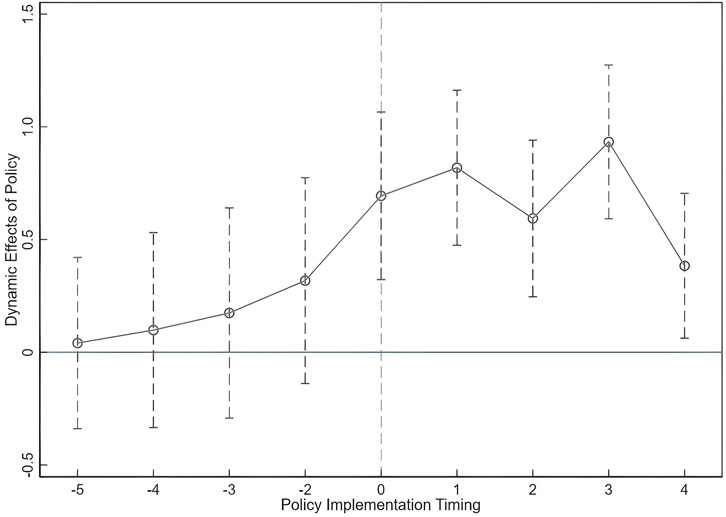
Figure 2. Parallel trend test. The figure plots the estimated coefficients and their 95% confidence intervals (represented by vertical lines) for the interaction terms between the treatment group dummy and year dummies relative to the policy implementation year (t = 0, marked by the vertical dashed line). The horizontal dashed line at zero indicates the null effect. The absence of statistically significant effects (confidence intervals overlapping zero) in the pre-treatment periods (t < 0) supports the validity of the parallel trends assumption, a prerequisite for causal inference using DID. The emergence of significant positive effects (confidence intervals excluding zero) post-implementation (t ≥= 0) indicates the dynamic effect of the CRCC policy.
5.3 Placebo test
To rule out the influence of unobserved factors and omitted variables on the benchmark regression results, the placebo test method is further employed to examine the robustness of the results. Referring to the approach of Yu M. G. et al. (2024), this paper constructs pseudo-policy implementation time and a pseudo-treatment-group dummy variable by randomly selecting CRCC pilot cities and their policy implementation time. Sampling is repeated 500 times among 296 cities, and each time the treatment group and policy time are randomly determined, thus ensuring the randomness of policy implementation. Figure 3 reports the P-values of the estimated coefficients of policy implementation and the kernel density distribution. The estimated values of the effects of the randomly simulated CRCC are concentrated around 0, indicating that unobserved factors do not affect the empirical results of this paper, and the benchmark regression results are robust.
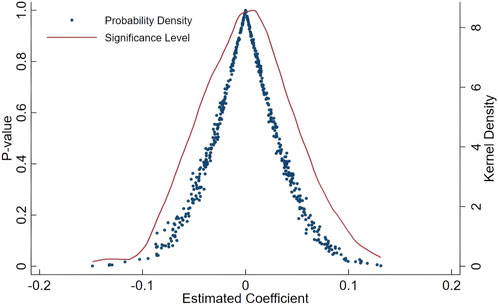
Figure 3. Placebo test results. The kernel density distribution (curve) shows the estimated coefficients from 500 random reassignments of the treatment group and policy timing.
5.4 Addressing endogeneity issues
5.4.1 Propensity score matching-difference-in-differences (PSM - DID) method
Considering that the selection of pilot cities may be non-random, which may lead to selection bias in the estimation results, this paper uses the PSM-DID method to further test the robustness of the policy effects. First, the probability of each city being approved as a policy pilot is estimated based on urban characteristics. Then, cities in the control group that are closest in terms of the pilot probability to those in the treatment group are matched. Finally, the DID method is used to re-estimate the impact of CRCC on urban green transformation. The standardized bias graph in Figure 4 shows that after matching, the standardized biases of all covariates have decreased significantly and approached 0 (most are less than 10%), indicating that the distributions of the treatment group and the control group on the matching variables are highly consistent, meeting the co - support domain condition. The establishment of the co - supporting hypothesis means that the characteristic differences between the treatment group and the control group before the policy implementation can be eliminated through matching, effectively solving the problem of sample selection bias. Column (1) of Table 3 reports the estimation results of the PSM - DID method. It can be seen that the estimated coefficient of the pilot policy is significantly positive, meaning that the promoting effect of CRCC on green transformation is robust.
5.4.2 Instrumental variable method
To further address potential endogeneity issues, this paper uses the Two-Stage Least Squares (2SLS) method for robustness testing. The selection of instrumental variable needs to satisfy the principles of relevance and exclusivity. On the one hand, instrumental variable need to be highly correlated with the core explanatory variable (
This paper estimates the instrumental variable results of river density in columns (2) and (3) of Table 3. In the first-stage regression, the instrumental variable coefficient is statistically significant, indicating that the instrumental variable has a strong correlation with climate-resilient city construction. The Kleibergen-Paap rk Wald F value is greater than the critical value level of the Stock-Yogo test at 10%, excluding the problem of weak instrumental variables. The P-value of the Kleibergen-Paap LM statistic is less than 1%, strongly rejecting the hypothesis of insufficient instrumental variable identification. In the second-stage regression, the
5.5 Robustness tests
5.5.1 Replacing the dependent variable
To assess the robustness of the model results from the perspective of variable measurement, this paper replaces the proxy variable for the degree of urban green transformation. In the benchmark regression, green technology innovation was measured by the number of green invention patent applications. Here, we use the total number of green patent applications to re-evaluate the impact of CRCC on urban green transformation. This substitution considers that green patent applications in a broader sense can more comprehensively reflect a city’s overall efforts and achievements in green technology innovation and industrial transformation. The regression results after replacing the dependent variable are reported in Column (1) of Table 4. The coefficient of the core explanatory variable
5.5.2 Adjusting the time window
Since the impact of the pilot policy may have a lag effect, the choice of different time windows before and after the policy implementation may also have a certain impact on the estimation results. To eliminate the bias in the regression results caused by sample selection, this paper adjusts the time window. Specifically, two new time windows, 2010–2022 and 2012–2022, are reset to replace the basic time window, in order to capture the variation in policy effects over different time periods. Column (2) and Column (3) of Table 4 respectively show the regression results under different time windows. It is found that the regression coefficients of CRCC are significantly positive, indicating that the research results are robust.
5.5.3 Winsorization
To eliminate the possible influence of extreme outliers in various variables on the evaluation of policy effects, this paper conducts bilateral winsorization on all variables at the 1% level. Column (4) of Table 4 reports the regression results of the pilot policy under the condition of winsorizing from 1% to 99%. It is found that the regression coefficient of
5.5.4 CIC model test
To address the problem that DID cannot handle unobservable heterogeneity (De Chaisemartin and d’Haultfoeuille, 2022), this paper refers to the DID method proposed by Athey and Imbens (2006) that allows for non - linearity and differences among individuals, also known as the changes-in-changes (CIC) model. The CIC method accurately identifies the net effect of a policy by analyzing the differences in changes between the treatment group (the group affected by a specific policy) and the control group (the group not affected) before and after the policy implementation. Column (5) of Table 4 reports the regression results of applying the CIC model. It is found that CRCC still has a significant promoting effect on green transformation, further corroborating the robustness of the benchmark regression results.
5.5.5 Counterfactual test
Before using the DID model for analysis, it is crucial to ensure that the experimental group and the control group are sufficiently comparable to avoid potential biases in the causal identification process. This paper conducts a counterfactual test by setting up a dummy variable for a false policy implementation time. Specifically, the policy implementation time of CRCC is advanced to 2013 and 2015 respectively, and then estimated using Equation 1. The regression results are shown in Column (6) and Column (7) of Table 4. It can be observed that after advancing the policy time, the regression coefficients of
5.6 Analysis of influence mechanisms
5.6.1 Mediating effects of industrial structure and government behavior
The benchmark regression and analysis above indicate that building climate-resilient cities has a positive effect on accelerating green transformation. However, with the gradual promotion and implementation of this concept in China, merely exploring the direct effects of CRCC is no longer sufficient. To more effectively promote the green transformation process and achieve a win-win situation in environmental protection and economic development, we must deeply analyze the action mechanisms of CRCC and the synergistic effects of its supporting policies. Therefore, this section will focus on exploring the action mechanisms by which CRCC promotes green transformation and conduct further analysis and elaboration.
Referring to the approach of Zhang Y et al. (2024), the following econometric models are set up:
In Equation 3,
Government behavior is divided into incentive behavior (
Table 5 presents the results of the mechanism analysis regarding the impact of CRCC on green transformation. The findings in columns (1) and (2) indicate that CRCC significantly promotes both the upgrading and rationalization of the industrial structure. This suggests that the pilot policy accelerates urban green transformation by optimizing the industrial structure, which in turn enhances resource utilization efficiency. In column (3), the significantly positive regression coefficient of CRCC on government support for science and technology implies that the pilot policy spurs local governments to increase financial support for green technologies. This, in turn, propels the research, development, and application of green technologies, thereby facilitating urban green transformation. The results in column (4) demonstrate that CRCC remarkably strengthens the intensity of environmental regulation. This reveals that through the government’s restrictive actions, the pilot policy creates a “back-forcing” mechanism for polluting enterprises. This mechanism compels enterprises to adopt more environmentally-friendly production methods, thus driving urban green transformation. Our findings complement recent research on regional sustainability by addressing a critical gap. While studies like Peng et al. (2024) assess water sustainability through static resource indicators (e.g., water quantity, quality), our research dynamic ally evaluates how policy interventions can actively reshape urban systems toward green goals. For example, the identification of industrial structure upgrading and governmental behavior as key mechanisms highlights the role of policy in fostering pro-innovation incentives and regulatory reforms, which are absent in traditional resource accounting frameworks. In summary, CRCC effectively promotes urban green transformation through multi-dimensional mechanisms.
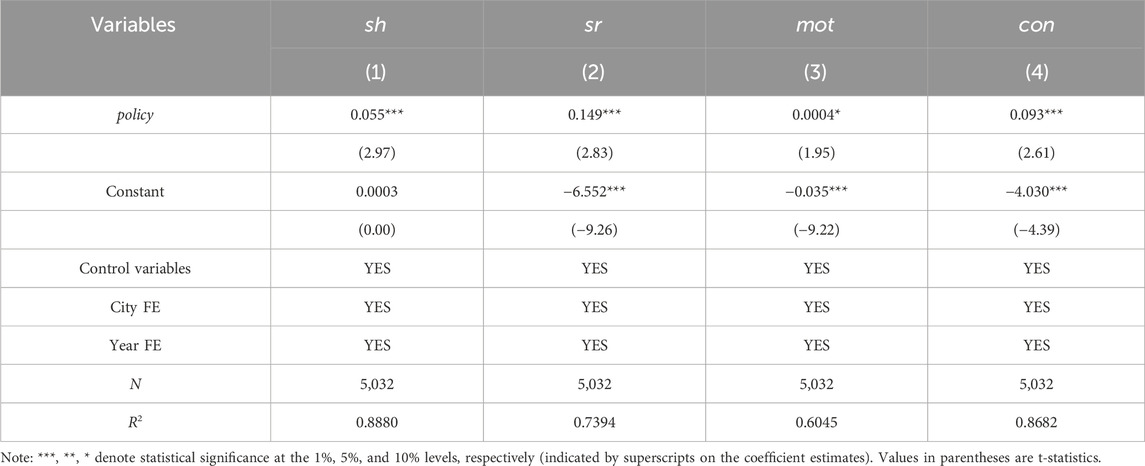
Table 5. Mediation effect test: transmission mechanism between industrial structure and government behavior.
5.6.2 Heterogeneity of mediating effects across subgroups
To further explore the heterogeneous mediating effects of the CRCC policy on urban green transformation across different city subgroups, this study examines the interactive effects of the policy with resource-based city status (
According to the empirical results in Table 6, the interaction term
In terms of administrative hierarchy heterogeneity, the interaction term
5.7 Heterogeneity analysis
5.7.1 Division by the “Hu Huanyong Line”
The division of the “Hu Huanyong Line” is based on a comprehensive consideration of China’s natural geographical conditions, especially the significant influence of climate and terrain factors. It quantitatively depicts the spatial characteristics of China’s population for the first time, revealing the fact that there is a huge disparity in population density between the southeastern and northwestern halves of China. This line has important guiding significance for understanding China’s national conditions and formulating regional development policies (Zhao and Zhang, 2022). In this paper, China is divided into the southeastern side and the northwestern side according to the “Hu Huanyong Line”, and the impact of CRCC on green transformation is explored separately. The results are shown in columns (1)–(2) of Table 7. It can be found that in the southeastern region, CRCC significantly promotes green transformation in this area; while in the northwestern region, the regression coefficient of
5.7.2 Division by location in the Yangtze River Economic Belt
The Yangtze River Economic Belt, as a crucial economic corridor spanning east-west and running through north-south in China, clearly holds a core position in the country’s economic development system. The Third Plenary Session of the 20th Central Committee of the Communist Party of China explicitly proposed to “optimize the development mechanism of the Yangtze River Economic Belt”, which profoundly reflects the country’s high hopes for the Yangtze River Economic Belt in leading green transformation and sustainable development. In light of this, grouping cities for research based on whether they are located in the Yangtze River Economic Belt is not merely a simple geographical division but a deep-seated consideration based on national development strategies and economic layouts. Columns (3)–(4) of Table 7 report the impact of CRCC on green transformation in the Yangtze River Economic Belt region and non-Yangtze River Economic Belt region respectively. The results show that the pilot of CRCC in the Yangtze River Economic Belt region can significantly promote green transformation, while for the non-Yangtze River Economic Belt region, the effect of CRCC in promoting green transformation is not yet obvious. A possible reason is that, as an important area for China’s economic development, the Yangtze River Economic Belt has received high-level attention from the national level and a series of policy supports. This has not only promoted the rapid growth of the regional economy but also provided a strong institutional guarantee for CRCC and green transformation (Yang and Pan, 2024).
5.8 Examining whether the policy can achieve an “environment-friendly” outcome
The previous sections have clearly demonstrated the significant positive effect of CRCC on promoting urban green transformation, effectively facilitating cities’ progress towards a more sustainable and low-carbon direction. On this basis, this paper further explores the in-depth impact of CRCC in the field of environmental protection, especially its potential for reducing pollutant emissions and building an “environment-friendly” city. Referring to the research of Chen et al. (2022), this paper selects industrial wastewater, industrial sulfur dioxide, and industrial smoke and dust as key pollutant indicators, and constructs a comprehensive environmental pollution index using the entropy-weight method. The larger this index is, the more pollutants are emitted. Column (1) of Table 8 reports the results of the impact of CRCC on pollutant emissions. It can be found that the regression coefficient is significantly negative, indicating that CRCC helps to reduce pollutant emissions. In addition, this paper further uses the pollutant emission level per unit of GDP as an evaluation indicator, that is, calculating the ratio of the total emissions of industrial wastewater, industrial sulfur dioxide, and industrial smoke and dust to GDP, to measure the environmental efficiency of urban economic development. The results in column (2) of Table 8 show that CRCC significantly inhibits the pollutant emission level per unit of GDP, indicating that while maintaining economic growth, the environmental efficiency of the city has been significantly improved, achieving a win-win situation for economic development and environmental protection.
6 Further analysis
The construction of climate-resilient cities has a promoting effect on urban green transformation. This may encourage neighboring regions to learn and imitate, adopt similar CACC strategies, and thus promote the deepening of economic green transformation in these cities, forming a positive spatial spillover effect. To empirically test whether CRCC generates spillover effects on neighboring cities’ green transformation, we employ spatial econometric models. These methods specifically measure how one city’s characteristics influence its neighbors - answering whether CRCC’s benefits extend beyond pilot cities.
However, the CACC may also lead to a siphon effect. That is, due to the first-mover advantage of CACC, core cities may attract high-quality resources from surrounding areas to converge, thereby inhibiting the economic green transformation process of surrounding cities and generating a negative spatial spillover effect. Figure 5 visualizes spatial patterns of green transformation using Local Moran’s I. The concentration of cities in “High-High” clusters (top-right quadrant) indicates that cities with advanced green transformation tend to be geographically grouped. This clustering pattern provides preliminary evidence that green transformation spreads across neighboring areas, justifying our spatial spillover analysis. It can be observed that most cities in 2010 and 2020 fall into the first quadrant (High-High clusters) and the third quadrant (Low-Low clusters). This clustering pattern reveals two key insights: (1) High-High clusters indicate that CRCC policies in pilot cities have promoted knowledge diffusion and policy emulation among neighboring cities, forming a positive spatial spillover effect; (2) Low-Low clusters suggest regional disparities in green transformation, possibly due to weak policy implementation or resource constraints in underdeveloped areas. These findings imply that policymakers should strengthen cross-regional cooperation mechanisms to leverage the demonstration effect of High-High clusters and address the lagging development in Low-Low regions, thereby promoting coordinated regional green transformation.
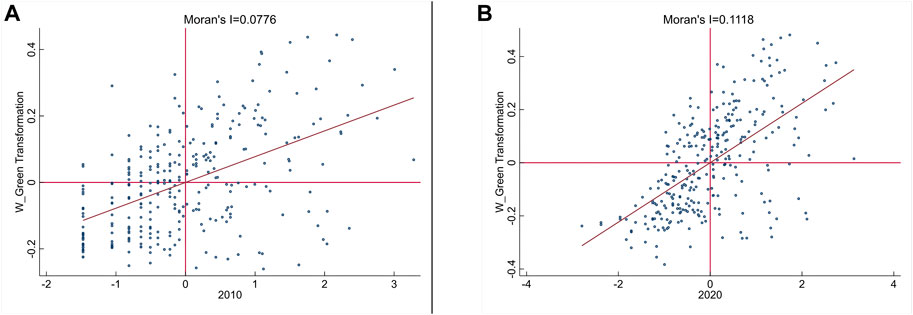
Figure 5. Moran’s Scatterplots for Urban Green Transformation. The plots assess the spatial autocorrelation of the green transformation index across cities in (A) 2010 and (B) 2020. Each point represents a city. The quadrants represent different types of local spatial association: High-High (HH, top-right), Low-High (LH, top-left), Low-Low (LL, bottom-left), High-Low (HL, bottom-right).
Furthermore, three spatial econometric models, namely the Spatial Autoregressive Model (SAR), the Spatial Error Model (SEM), and the Spatial Durbin Model (SDM), are established to analyze the spatial effects of CACC on urban green transformation. The results of the three spatial models in columns (1)–(3) of Table 9 consistently demonstrate that the coefficient of the CRCC policy (
To accurately analyze the overall impact of CRCC, columns (4)–(6) report the direct effect, indirect effect (spillover effect), and total effect estimated using the preferred SDM model. The direct effect (0.127) quantifies the impact of implementing CRCC in a specific city on its own level of green transformation, and this value is positive and significant. The indirect effect (2.754) measures the average impact of implementing CRCC in all other cities on the level of green transformation of any single city. Its significantly large positive value indicates that the implementation of CRCC in neighboring cities generates a substantial positive spillover effect. The total effect (2.881), which is the sum of the direct and indirect effects, represents the comprehensive impact of implementing CRCC across various locations on the green transformation of a single city, and it also presents a significant positive value. These reliable research results indicate that the benefits brought by CRCC are not limited to the pilot cities themselves. The significant positive spillover effects suggest that CRCC can create a virtuous cycle through knowledge sharing, policy emulation, or the strengthening of regional infrastructure and networks. Evidently, the “demonstration effect” of CRCC appears to outweigh any potential “siphon effect” that might lead to the loss of resources from neighboring cities.
7 Conclusions and policy recommendations
This paper takes the CACC as the research starting point. Based on the panel data of 296 prefecture-level and above cities in China from 2006 to 2022, the DID method is used to empirically test the impact of climate resilience on urban green transformation. Moreover, through mechanism tests, heterogeneity analysis, and spatial econometric models, a comprehensive and systematic quantitative investigation is carried out from multiple-dimensional perspectives. The main research conclusions are as follows: first, the CACC can significantly accelerate urban green transformation, and this conclusion still holds after a series of robustness tests. Second, the mechanism tests indicate that the CACC can not only achieve the upgrading and rationalization of the industrial structure but also influence the incentive and restrictive behaviors of the government, thus accelerating urban green transformation. In addition, heterogeneity analysis of mediating effects indicates that CRCC faces constraints from rigid industrial structures in resource-based cities, yielding weaker promotion of green transformation, whereas in cities with higher administrative hierarchy, the policy more effectively facilitates green transformation by accelerating industrial structure upgrading and enhancing governmental incentives for green innovation, providing empirical basis for differentiated policy formulation. Third, in terms of heterogeneity analysis, the green-transformation effect of CACC is more obvious in cities on the southeastern side of the “Hu Huanyong Line”, and node cities in the Yangtze River Economic Belt. Fourth, the CACC can significantly reduce pollutant emissions and the pollutant emission level per unit of GDP, thus effectively promoting the construction of an “environment-friendly” society. Fifth, the expansion tests show that the CACC can considerably promote the green-transformation process of neighboring cities, and there is a positive spillover effect in the green-transformation itself.
Based on the above research conclusions, the following policy recommendations are put forward in this paper. First, governments should establish coordination mechanisms among enterprises, residents, NGOs, and academia, while tailoring strategies to regional heterogeneity. For cities southeast of the Hu Line and in the Yangtze River Economic Belt, which have advanced economic bases and strong implementation capacities, market-driven tools like carbon trading and green bonds should be piloted to leverage their economic advantages. These instruments can efficiently guide resources toward low-carbon sectors and accelerate industrial green transformation. In contrast, northwestern cities and non-provincial capitals face constraints in natural environment and industrial structure, requiring targeted fiscal transfers and technology support. Special funds should be allocated to support ecological restoration and clean energy projects, while tax incentives can encourage enterprises to adopt green technologies and facilitate the transition of resource-based industries.
Second, provincial capital cities, as economic and administrative centers, should utilize their resource endowments to coordinate cross-sectoral resources and set green industry standards. They can allocate more funds to green infrastructure and scientific research, and establish industry-academia-research cooperation platforms to promote the commercialization of green technologies. Non-provincial capital cities, with relatively limited resources, may need simplified procedures for green projects and targeted training for local officials to enhance policy implementation capabilities.
Third, building directly on the finding of significant positive spatial spillovers, to amplify these beneficial ripple effects of CRCC, inter-city platforms should be created to share best practices and green patents. Cities in the Yangtze River Economic Belt can provide financial support for green infrastructure in neighboring regions to mitigate potential siphon effects, while compensation mechanisms can balance interests during industrial transitions. For example, transitional funding can assist high-emission enterprises in adopting sustainable practices, fostering coordinated development across regions.
Finally, a multi-dimensional evaluation framework should integrate indicators such as corporate emission reductions, resident participation, and NGO project outcomes, with regular progress reports to ensure transparency. Annual stakeholder forums can gather feedback to adjust policies, such as fine-tuning subsidy ratios for enterprises in different regions or enhancing resident engagement incentives, to address on-the-ground challenges effectively. These recommendations directly respond to the heterogeneity findings, ensuring that policy tools are context-specific and aligned with regional development stages.
The conclusions revealed in this paper, such as the green transformation of climate-adaptive city construction driven by industrial structure optimization and the government’s incentive and restraint behaviors, as well as the existence of positive spatial spill - over effects, are of great reference significance for regions at different development stages and with different geographical backgrounds. CRCC’s model of top-down policy piloting and bottom-up industrial adjustment offers developing economies a scalable path under the Paris Agreement, adaptable to local resources and governance. First of all, developing countries can learn from China’s experience. They can guide resources to flow to low - carbon sectors through green industrial policies and strengthen the government’s leading role in environmental regulation and technological innovation. Secondly, regions with similar geographical or economic characteristics can establish policy coordination mechanisms to amplify the spatial spill-over effects of green transformation. Finally, at the trans-national level, the flexible adaptation of policy tools can provide micro-level practical approaches for global climate governance, thus helping to achieve the coordinated goal of climate adaptation and green development.
Data availability statement
The original contributions presented in the study are included in the article/supplementary material, further inquiries can be directed to the corresponding author.
Author contributions
CG: Conceptualization, Methodology, Project administration, Resources, Writing – original draft. CZ: Supervision, Writing – review and editing. YW: Data curation, Software, Writing – review and editing. CW: Conceptualization, Methodology, Software, Writing – original draft.
Funding
The author(s) declare that financial support was received for the research and/or publication of this article. This work has been supported by the Excellent Youth funding of Hunan Provincial Education Department (Grant No. 23B0600).
Conflict of interest
The authors declare that the research was conducted in the absence of any commercial or financial relationships that could be construed as a potential conflict of interest.
Generative AI statement
The author(s) declare that no Generative AI was used in the creation of this manuscript.
Publisher’s note
All claims expressed in this article are solely those of the authors and do not necessarily represent those of their affiliated organizations, or those of the publisher, the editors and the reviewers. Any product that may be evaluated in this article, or claim that may be made by its manufacturer, is not guaranteed or endorsed by the publisher.
References
Athey, S., and Imbens, G. W. (2006). Identification and inference in nonlinear difference-in-differences models. Econometrica 74 (2), 431–497. doi:10.1111/j.1468-0262.2006.00668.x
Biswas, R. R., and Rahman, A. (2023). Adaptation to climate change: a study on regional climate change resilience policy and practice framework. J. Environ. Manag. 336, 117666. doi:10.1016/j.jenvman.2023.117666
Chen, W., Xiang, Y., Liu, J., and Zhu, Y. (2022). Foreign investor and industrial pollution: evidence from sulfur dioxide emission. Fin. Res. Lett. 50, 103279. doi:10.1016/j.frl.2022.103279
Chen, Y., Chen, S., and Miao, J. (2024). Does smart city pilot improve urban green economic efficiency: accelerator or inhibitor. Environ. Impact Assess. Rev. 104, 107328. doi:10.1016/j.eiar.2023.107328
Chen, Y., Li, J., Hu, Y., and Liu, L. (2023). Spatial and temporal characteristics of nighttime UHII based on local climate zone scheme using mobile measurement: a case study of changsha. Build. Environ. 228, 109869. doi:10.1016/j.buildenv.2022.109869
Chiriluş, A., and Costea, A. (2023). The effect of FDI on environmental degradation in Romania: testing the pollution haven hypothesis. Sustainability 15 (13), 10733. doi:10.3390/su151310733
Cid, A., and Lerner, A. M. (2023). Local governments as key agents in climate change adaptation: challenges and opportunities for institutional capacity-building in Mexico. Clim. Policy 23 (5), 649–661. doi:10.1080/14693062.2022.2163972
Cui, Y., Tang, J., and He, B. J. (2024). Progressive trend, conceptual terminology, and future directions of green façade research: a review of literature in 2010–2023. Int. J. Environ. Sci. Technol., 1–20. doi:10.1007/s13762-024-06030-8
De Chaisemartin, C., and d’Haultfoeuille, X. (2020). Two - way fixed effects estimators with heterogeneous treatment effects. Am. Econ. Rev. 110 (9), 2964–2996. doi:10.1257/aer.20181169
Deng, S. C., and Wu, Y. M. (2024). The impact of low - carbon city pilot policies on the green transformation development of resource - based cities in China. Chin. J. Popul. Resour. Environ. 34, 65–79.
Dou, R. Y., Jiao, B. B., Zhang, W. J., and Zhang, P. f. (2023). Research on spatiotemporal heterogeneity and driving forces of green development efficiency in resource-based cities of Western China. J. Nat. Resour. 38 (1), 238–254. doi:10.31497/zrzyxb.20230115
Du, K., Cheng, Y., and Yao, X. (2021). Environmental regulation, green technology innovation, and industrial structure upgrading: the road to the green transformation of Chinese cities. Energ. Econ. 98, 105247. doi:10.1016/j.eneco.2021.105247
Dunbar, K., Treku, D., Sarnie, R., and Hoover, J. (2023). What does ESG risk premia tell Us about mutual fund sustainability levels: a difference - in - differences analysis. Financ. Res. Lett. 57, 104262. doi:10.1016/j.frl.2023.104262
Dzwigol, H., Kwilinski, A., Lyulyov, O., and Pimonenko, T. (2023). The role of environmental regulations, renewable energy, and energy efficiency in finding the path to green economic growth. Energies 16 (7), 3090. doi:10.3390/en16073090
Gao, J., Hua, G., Huo, B., Randhawa, A., and Li, Z. (2025). Pilot policies for low - carbon cities in China: a study of the impact on green finance development and energy carbon efficiency. Clim. Policy 25 (1), 137–152. doi:10.1080/14693062.2024.2361703
Hao, X., Wang, X., Wu, H., and Hao, Y. (2023). Path to sustainable development: does digital economy matter in manufacturing green total factor productivity? Sustain. Dev. 31 (1), 360–378. doi:10.1002/sd.2397
Huang, C., Tan, X. C., and Guo, J. X. (2021). An international comparative research of the climate adaptation governance and its strategic implications. Sci. Res. Manag. 42 (2), 20–29. doi:10.19571/j.cnki.1000-2995.2021.02.003
Hunjra, A. I., Zhao, S., Tan, Y., Bouri, E., and Liu, X. (2024). How do green innovations promote regional green total factor productivity? Multidimensional analysis of heterogeneity, spatiality and nonlinearity. J. Clean. Prod. 467, 142935. doi:10.1016/j.jclepro.2024.142935
Lee, E. (2020). Environmental regulation and financial performance in China: an integrated view of the porter hypothesis and institutional theory. Sustainability 12 (23), 10183. doi:10.3390/su122310183
Li, B., Qin, H., and Sun, W. (2022). Interaction mechanism between industrial transformation and upgrading and green total factor productivity improvement: an empirical study based on 116 China's prefecture-level resource-based cities. J. Nat. Resour. 37 (1), 186–199. doi:10.31497/zrzyxb.20220113
Li, J., and Li, Y. (2024). Digitalization, green transformation, and the high-quality development of Chinese tourism enterprises. Financ. Res. Lett. 66, 105588. doi:10.1016/j.frl.2024.105588
Li, Y. (2023). A systematic review of rural resilience. China Agr. Econ. Rev. 15 (1), 66–77. doi:10.1108/CAER-03-2022-0048
Li, Y. X., Cheng, H. F., and Ni, C. J. (2023). Energy transition policy and urban green innovation vitality: a quasi-natural experiment based on the new energy demonstration city policy. Chin. J. Popul. Resour. Environ. 33 (1), 137–149.
Li, Z., Huang, Z., and Su, Y. (2023). New media environment, environmental regulation and corporate green technology innovation: evidence from China. Energy Econ. 119, 106545. doi:10.1016/j.eneco.2023.106545
Lin, S., Zhou, Z., Hu, X., Chen, S., and Huang, J. (2024). How can urban economic complexity promote green economic growth in China? The perspective of green technology innovation and industrial structure upgrading. J. Clean. Prod. 450, 141807. doi:10.1016/j.jclepro.2024.141807
Liu, C., Tang, C., and Liu, Y. (2024). Does the transformation of energy structure promote green technological innovation? A quasi - natural experiment based on new energy demonstration city construction. Geosci. Front. 15 (3), 101615. doi:10.1016/j.gsf.2023.101615
Liu, H., Lei, H., and Zhao, S. (2023). The impact of FDI on industrial structure upgrading and carbon emission under the constraints of environmental regulation. Environ. Technol. 45 (25), 5483–5500. doi:10.1080/09593330.2023.2295830
Liu, Q., and Yin, Y. (2024). Strategies for emission reduction in construction: the role of China’s carbon trading market. J. Know. Econ. 16, 3000–3029. doi:10.1007/s13132-024-02009-5
Liu, X. L., Li, W. T., Guo, P. B., Shen, J., Xiong, R., Cui, J., et al. (2024). Can location-oriented policies promote the green transformation of resource-based cities? Taking the establishment of “Comprehensive Reform Zone” in Shanxi as an example. J. Nat. Resour. 39 (1), 84–103. doi:10.31497/zrzyxb.20240105
Liu, Y., Xie, Y., and Zhong, K. (2024). Impact of digital economy on urban sustainable development: evidence from Chinese cities. Sustain. Dev. 32 (1), 307–324. doi:10.1002/sd.2656
Ma, R., and Lin, B. (2025). The impact of digital technology innovation on energy-saving and emission reduction based on the urban innovation environment. J. Environ. Manag. 375, 124176. doi:10.1016/j.jenvman.2025.124176
Ma, S., Li, Z., Li, L., and Yuan, M. (2023). Coupling coordination degree spatiotemporal characteristics and driving factors between new urbanization and construction industry: evidence from China. Eng. Constr. Archit. Manag. 30 (10), 5280–5301. doi:10.1108/ECAM-05-2022-0471
Ma, X., and Zhu, L. (2024). Impact of low - carbon city pilot policies on green construction industry innovation. Sustainability 16 (7), 2964. doi:10.3390/su16072964
Mahmoud, I., Dubois, G., Liquete, C., and Robuchon, M. (2025). Understanding collaborative governance of biodiversity-inclusive urban planning: methodological approach and benchmarking results for urban nature plans in 10 European cities. Urban Ecosyst. 28 (2), 17. doi:10.1007/s11252-024-01656-5
Mao, Y., Xie, Y., and Zhuo, C. (2024). How does international transport corridor affect regional green development: evidence from the China - europe railway express. J. Environ. Plan. Manag. 67 (7), 1602–1627. doi:10.1080/09640568.2023.2176296
Meng, C., Shi, D., and Wang, B. (2023). The impact of green human capital of entrepreneur on enterprise green innovation: a study based on the theory of pro-environmental behavior. Fin. Res. Lett. 58, 104453. doi:10.1016/j.frl.2023.104453
Pan, Y., Teng, T., Wang, S., and Wang, T. (2024). Impact and mechanism of urbanization on urban green development in the yangtze river economic belt. Ecol. Indic. 158, 111612. doi:10.1016/j.ecolind.2024.111612
Peng, Q., He, W., Kong, Y., Shen, J., Yuan, L., and Ramsey, T. S. (2024). Spatio-temporal analysis of water sustainability of cities in the yangtze river economic belt based on the perspectives of quantity-quality-benefit. Ecol. Indic. 160, 111909. doi:10.1016/j.ecolind.2024.111909
Ren, S., Huang, M., Liu, D., and Yan, J. (2023). Understanding the impact of mandatory CSR disclosure on green innovation: evidence from Chinese listed firms. Br. J. Manag. 34 (2), 576–594. doi:10.1111/1467-8551.12609
Ren, S. G., Zhou, L. Q., and Wang, Y. J. (2024). Can green performance evaluation break the ‘resource curse’? Empirical evidence from resource-based. Chin. J. Popul. Resour. Environ. 34 (2), 142–154.
Shahani, F., Pineda - Pinto, M., and Frantzeskaki, N. (2022). Transformative low - carbon urban innovations: operationalizing transformative capacity for urban planning. Ambio 51 (5), 1179–1198. doi:10.1007/s13280-021-01653-4
Shang, W. L., and Lv, Z. (2023). Low carbon technology for carbon neutrality in sustainable cities: a survey. Sustain. Cities Soc. 92, 104489. doi:10.1016/j.scs.2023.104489
Sharifi, A., Allam, Z., Bibri, S. E., and Khavarian - Garmsir, A. R. (2024). Smart cities and sustainable development goals (SDGs): a systematic literature review of co - benefits and trade - offs. Cities 146, 104659. doi:10.1016/j.cities.2023.104659
Shen, J. L., Xu, H., Li, J. F., and Song, J. F. (2023). The impact of farmers’ adaptive behavior to climate change on their water poverty. Resour. Sci. 45 (7), 1410–1423. doi:10.18402/resci.2023.07.10
Sibiya, N., Sithole, M., Mudau, L., and Simatele, M. D. (2022). Empowering the voiceless: securing the participation of marginalised groups in climate change governance in South Africa. Sustainability 14 (12), 7111. doi:10.3390/su14127111
Sun, L., and Feng, N. (2023). Research on fiscal policies supporting green and low-carbon transition to promote energy conservation and emission reduction in cities: empirical evidence from China. J. Clean. Prod. 430, 139688. doi:10.1016/j.jclepro.2023.139688
Sun, X., Zhang, R., Yu, Z., Zhu, S., Qie, X., Wu, J., et al. (2024). Revisiting the porter hypothesis within the economy - environment - health framework: empirical analysis from a multidimensional perspective. J. Environ. Manag. 349, 119557. doi:10.1016/j.jenvman.2023.119557
Tang, L., and Chen, X. G. (2024). Can digital finance alleviate the adverse effects of short⁃term loans for long⁃term investments on corporate sustainable green innovation? Chin. J. Popul. Resour. Environ. 34, 123–131.
Wang, J. (2024). Power source and driving factors of green transformation of resource-based cities in China. Econ. Geogr. 44 (4), 75–83+99. doi:10.15957/j.cnki.jjdl.2024.04.008
Wang, L., and Cheng, Z. (2024). Impact of the belt and road initiative on enterprise green transformation. J. Clean. Prod. 468, 143043. doi:10.1016/j.jclepro.2024.143043
Wang, Q., and Ma, L. (2024). Spatial differentiation and endogenous driving mechanisms of China’s energy transition. Resour. Sci. 46 (9), 1709–1722. doi:10.18402/resci.2024.09.04
Wang, W. G., Zhang, Y. J., and Qiu, D. X. (2024). Theoretical mechanism and empirical evidence of population aging, fiscal expenditure efficiency and industrial structure upgrading. Stat. Res. 41 (7), 134–147. doi:10.19343/j.cnki.11-1302/c.2024.07.009
Wang, W. L., Wang, J. L., Xie, C. X., and Li, Z. F. (2023). Impact of ‘Made in China 2025’ pilot demonstration city construction on urban green development efficiency. Chin. J. Popul. Resour. Environ. 33 (9), 147–158.
Wang, Y., Bai, Y., Quan, T., Ran, R., and Hua, L. (2023). Influence and effect of industrial agglomeration on urban green total factor productivity: on the regulatory role of innovation agglomeration and institutional distance. Econ. Anal. Policy 78, 1158–1173. doi:10.1016/j.eap.2023.04.024
Wang, Y., and Zhang, S. L. (2024). Impact of the ‘environmental protection vertical reform’ policy on urban economic green transition from the perspective of environmental decentralization. Chin. J. Popul. Resour. Environ. 34 (8), 47–58.
Wei, L. L., and Hou, Y. Q. (2022). Research on the impact of China's digital economy on urban green development. Quant. Tech. Econ. Res. 39, 60–79. doi:10.13653/j.cnki.jqte.2022.08.005
Wu, Q., Sun, Z., Jiang, L., and Jiang, L. (2024). “Bottom-up” abatement on climate from the “top-down” design: lessons learned from China’s low-carbon city pilot policy. Empir. Econ. 66 (3), 1223–1257. doi:10.1007/s00181-023-02491-x
Wu, T., Yi, M., and Zhang, Y. (2024). Towards cities' green growth: the combined influence of economic growth targets and environmental regulations. Cities 146, 104759. doi:10.1016/j.cities.2023.104759
Yan, B., Yao, B., and Zhang, C. (2023). Industrial structure, high - quality development of logistics industry and the economy. PLoS One 18 (5), e0285229. doi:10.1371/journal.pone.0285229
Yang, S., Jahanger, A., Hu, J., and Awan, A. (2024). Impact of China's carbon emissions trading scheme on firm-level pollution abatement and employment: evidence from a national panel dataset. Energ. Econ. 136, 107744. doi:10.1016/j.eneco.2024.107744
Yang, X., and Ran, G. (2024). Factors influencing the coupled and coordinated development of cities in the yangtze river economic belt: a focus on carbon reduction, pollution control, greening, and growth. J. Environ. Manag. 370, 122499. doi:10.1016/j.jenvman.2024.122499
Yang, Y., and Pan, H. (2024). The digital economy’s impact on the high - quality development of the manufacturing industry in China’s yangtze river economic belt. Sustainability 16 (16), 6840. doi:10.3390/su16166840
Yu, G., and Liu, K. (2024). Foreign direct investment, environmental regulation and urban green development Efficiency—an empirical study from China. Appl. Econ. 56 (23), 2738–2751. doi:10.1080/00036846.2023.2200232
Yu, H., Zhang, J., and Xu, N. (2023). Does national independent innovation demonstration zone construction help improve urban green total factor productivity? A policy assessment from China. Sustainability 15 (9), 7417. doi:10.3390/su15097417
Yu, M. G., An, J. F., Zheng, X. R., and Li, J. Y. (2024). The construction of a unified national market and high-quality financial development: a study based on breaking the segmentation of bond markets. Manag. World 40 (3), 1–16. doi:10.19744/j.cnki.11-1235/f.2024.0029
Yu, Q., Li, S., and Chen, N. (2024). Urbanization and greenhouse gas emissions from municipal wastewater in coastal provinces of China: spatiotemporal patterns, driving factors, and mitigation strategies. Environ. Res. 259, 119398. doi:10.1016/j.envres.2024.119398
Yuan, C., Han, Z., and Shang, M. (2024). Green growth through national urban agglomeration policy? Evidence from a quasi - natural experiment. J. Environ. Plan. Manag., 1–30. doi:10.1080/09640568.2024.2425711
Yuan, L., Zhou, Z., He, W., Wu, X., Degefu, D. M., Cheng, J., et al. (2025). A fuzzy logic approach within the DPSIR framework to address the inherent uncertainty and complexity of water security assessments. Ecol. Indic. 170, 112984. doi:10.1016/j.ecolind.2024.112984
Zeng, S., Jin, G., Tan, K., and Liu, X. (2023). Can low - carbon city construction reduce carbon intensity? empirical evidence from low - carbon city pilot policy in China. J. Environ. Manag. 332, 117363. doi:10.1016/j.jenvman.2023.117363
Zhang, B. B., Dong, A. R., and Duan, Y. W. (2024). How does the carbon peak target lead the low-carbon transformation of cities? Evidence from quasi-natural experiments. Quant. Econ. Tech. Econ. Res. 41, 177–196. doi:10.13653/j.cnki.jqte.20240523.001
Zhang, J., and Zheng, T. (2023). Can dual pilot policy of innovative city and low - carbon city promote green lifestyle transformation of residents? J. Clean. Prod. 405, 136711. doi:10.1016/j.jclepro.2023.136711
Zhang, R., Ying, W., Wu, K., and Sun, H. (2024). The impact of innovative human capital agglomeration on urban green development efficiency: based on panel data of 278 cities in China. Sustain. Cities Soc. 111, 105566. doi:10.1016/j.scs.2024.105566
Zhang, Y., Chen, Y., and Liu, X. (2024). Vertical reform of environmental protection, corruption and enterprise pollution reduction—a quasi - natural experiment based on 238 cities in China. Environ. Dev. Sustain., 1–31. doi:10.1007/s10668-024-05364-0
Zhang, Z. Q., Yao, M. Q., and Zheng, Y. (2024). Impact of the pilot policy for constructing climate resilient cities on urban resilience. Chin. J. Popul. Resour. Environ. 34 (4), 1–12. doi:10.12062/cpre.20230604
Zhao, G. Q., and Zhang, X. L. (2022). Can urbanization break through the “HuHuanyong line”? empirical test based on panel data of provinces in China from 2005 to 2020. China Soft Sci. (12), 89–101.
Keywords: climate resilient cities construction, green transformation, industrial structure, governmental behavior, spatial spillover effect
Citation: Gao C, Zhang C, Wen Y and Wang C (2025) How the climate resilient cities construction accelerates urban green transformation: impact effects and mechanism tests. Front. Environ. Sci. 13:1569938. doi: 10.3389/fenvs.2025.1569938
Received: 02 February 2025; Accepted: 30 June 2025;
Published: 16 July 2025.
Edited by:
Shilei Hu, Harbin Institute of Technology, ChinaReviewed by:
Liang Yuan, China Three Gorges University, ChinaWeifeng Gong, Qufu Normal University, China
Xianghua Yue, Xiangnan University, China
Qianqian Huang, Shanghai Jiao Tong University, China
Copyright © 2025 Gao, Zhang, Wen and Wang. This is an open-access article distributed under the terms of the Creative Commons Attribution License (CC BY). The use, distribution or reproduction in other forums is permitted, provided the original author(s) and the copyright owner(s) are credited and that the original publication in this journal is cited, in accordance with accepted academic practice. No use, distribution or reproduction is permitted which does not comply with these terms.
*Correspondence: Chunhui Wang, Y2hjdWZlNTUyMEAxMjYuY29t
 Chen Gao
Chen Gao Cuiping Zhang2
Cuiping Zhang2 Ya Wen
Ya Wen